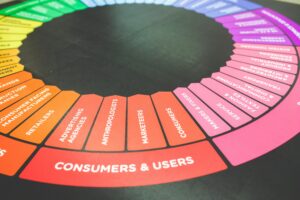The Psychology of Color in Digital Marketing: How Colors Influence Consumer Behavior

In the fast-paced world of digital marketing, grabbing attention and making a lasting impression is crucial. While visuals, content, and strategy all play their parts, there’s one often-overlooked element that holds surprising power—color psychology. The colors you choose for your branding, website, and advertisements can significantly influence how people perceive your brand and whether they take action.
Understanding the psychology of color in marketing helps you connect emotionally with your audience and improve your overall conversion rate. In this blog, we’ll explore how different colors trigger different emotions and how you can use this knowledge to boost your digital marketing results.
Why Psychology of Color in Digital Marketing Matters
Colors do more than make your website look pretty—they evoke feelings, build brand identity, and influence purchasing decisions. In fact, research shows that up to 90% of snap judgments about products are based on color alone.
When used correctly, colors can:
-
Encourage users to click your ads
-
Build trust with your audience
-
Enhance brand recognition
-
Increase user engagement
-
Drive more conversions
Color psychology isn’t just about making things look beautiful; it’s a strategic tool that can influence your audience’s decisions and behavior across digital channels. Brands that understand and apply it effectively are often more memorable and impactful.
Understanding the Psychology Behind Popular Colors
Let’s break down the emotions and associations commonly linked to different colors in marketing:
-
Red: Energy, urgency, and passion. Often used in clearance sales or food ads to trigger excitement and appetite.
-
Blue: Trust, calmness, and reliability. Popular among tech brands, banks, and healthcare companies.
-
Yellow: Optimism and youthfulness. It grabs attention but can be overwhelming if overused.
-
Green: Growth, health, and balance. Commonly used by eco-friendly or wellness brands.
-
Orange: Confidence and enthusiasm. Works well for calls-to-action and buttons.
-
Purple: Creativity, luxury, and wisdom. Great for beauty, fashion, or premium products.
-
Black: Sophistication and power. Often used in luxury branding and high-end digital campaigns.
-
White: Simplicity and cleanliness. Perfect for minimalist designs and clean UX.
Different audiences may also interpret colors differently based on culture, age, and gender, so always consider your target audience when choosing a palette.
How to Apply Color Psychology in Digital Marketing
-
Website Design
Your website’s color scheme should reflect your brand’s personality and purpose. For instance, if you run a digital marketing agency, a mix of blues and grays could help convey trust and professionalism. -
Social Media Graphics
Colors influence how your audience interacts with your posts. Warm tones like red and orange can drive engagement, while cool tones like blue and green feel more calming and reliable. -
Ad Campaigns
The color of your call-to-action (CTA) button can make a big difference. A red button might increase urgency, while a green one feels inviting and positive. -
Branding and Logo Design
Color is a key component of brand identity. Think about how top brands like Coca-Cola (red) or Facebook (blue) use color consistently to strengthen brand recall. -
Landing Pages and Email Marketing
Use contrasting colors to draw attention to CTAs, headlines, or offers. Keep the palette consistent with your overall branding to build trust.
Final Thoughts
In digital marketing, success isn’t just about what you say—it’s about how you make people feel. Color plays a vital role in shaping those emotions. By understanding color psychology, you can create visual experiences that not only attract attention but also build connection and trust with your audience.
Remember, the right color choices can increase engagement, build loyalty, and enhance the user experience across every touchpoint. So, next time you’re designing a campaign or building a landing page, don’t choose your colors randomly—choose them with purpose and intent. With the right color strategy, your brand can truly stand out in the crowded digital space.
Keywords used:
-
digital marketing
-
color psychology
-
branding
-
conversion rate
-
user experience
-
website design
-
call-to-action
-
brand identity